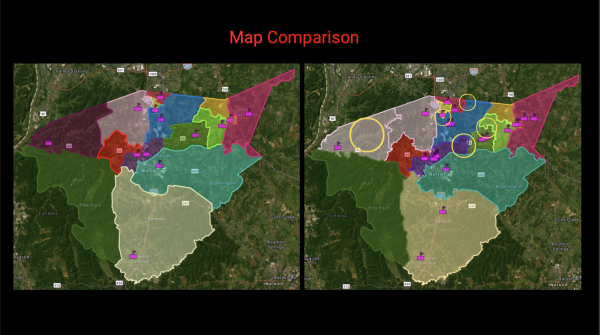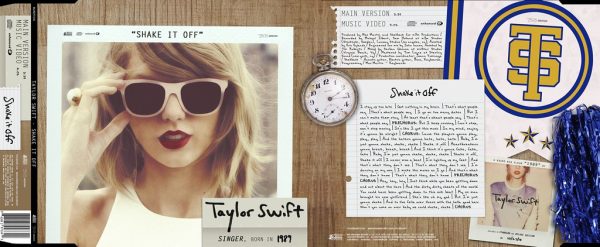Making Waves in Fashion
From left to right: Kyleigh Reeves, Cole Jeffries, Olivia Armstrong, Sam Mann. Four students are wearing some trends of 2019.
Explore your true style.
All throughout history, both boys and girls have used the changing world of fashion to express themselves.
The history of fashion has changed over the past century for boys and girls. Over the years, girls have made great strides throughout history and fashion, and it’s now acceptable to wear men’s clothing. On the other hand, boys have had a bigger stigma on what they wear, especially in the 21st century.
Pink and blue weren’t always the standard colors for a girl and boy. In the early 1900s, boys would wear pink and girls would wear blue. The reason is that being a more determined and stronger color, pink is more appropriate for a boy; while for the girl, blue, which is more delicate and graceful, is prettier. But the pink (for a girl) and blue (for a boy) became the new social norm in the United States during the 20th century. Fashion has broadened what is acceptable in today’s society. It has changed the way we look and wear clothing.
Girls’ trends started during the Victorian era. A woman of leisure was a woman of means. Pale skin, tight corsets, refined clothes of delicate fabrics, broken shoes, gloves — all this would be proof that she didn’t have to work and therefore had cash. “It was anticipated that a female of means would adopt fashion and beauty as her work: decorating a space, creating a soft atmosphere with her charm and grace,” said Komar, M. (2017, April 27). What Not to Wear: The Strange & Scary History of Women’s Dress Codes. Retrieved from https://www.bustle.com
In the old west, a woman by the name of Mary Susie fought for women’s right to wear pants for 20 years, but she never succeeded in earning that right. Then in the 1970s and 80s, women were allowed to wear “power suits” in the workplace. With less of a push-back, dressing up more masculine let a female enter her office. For example, a 1985 study found that female candidates in the interview who dressed up more masculine were considered to be considerably better for the position. More male clothing depicted a more male position, meaning they looked as if they could fill the role as a guy could, with traditional characteristics such as assertiveness, leadership, and endurance. “The corporate fashion change in the 1990s was intended to suggest a changing attitude towards females in power seats. They no longer needed shoulder pads to add some testosterone to their pencil skirts and maintain the people in the room comfortable,” said Komar, M. (2017, April 27). What Not to Wear: The Strange & Scary History of Women’s Dress Codes. Retrieved from https://www.bustle.com. For instance, no longer thinking that she required pants to strengthen her equality with masculine peers, Pat Schroeder, Colorado’s first female elected to Congress, liked wearing what she wanted and not thinking too much about them.
Hilary Clinton’s pantsuit is just one of the many styles that have come back in the 21st century. Based on a poll taken on the BE Livewire’s Instagram, fashion is going backward. For example, scrunchies and mom jeans have come back big time, along with high waisted jeans. For a lot of girls, fashion and clothing are about comfort and they don’t dress feminine or masculine. Men’s clothing tends to be bigger, making it more appealing to girls because they feel more comfortable in baggier clothing. Sophomore Kyleigh Reeves, says she describes her style as somewhere in the middle of masculine and feminine and kind of emo. “I go for more unisex items because they have the styles I like. I wear a lot of black & mainly band t-shirts, oversized sweatshirts, flannels, jeans, etc,” said Reeves
On the other hand, some dress more feminine, like Senior Olivia Armstrong. Some women find it empowering to dress more girly and feminine. “I think it has become a lot more liberated and more-so built on values of feminism. No longer are girls wearing ankle-length skirts or dresses and covering up, they’re embracing their femininity in what they wear and I think it’s such a cool thing. Fashion is such an amazing way to express both you physically and emotionally.” said Armstrong
In the early 1900s, the trend for men was a suit that consisted of 3 main things: a jacket, a pair of trousers, and a vest. This later turned into a straightforward single-stranded jacket with narrow lapels that are coupled with a pair of trousers. Towards the end of the 1920s, the biggest trend was bow ties and fedoras. By the 1940s, men would wear a standard suit to work with a trench coat and a colorful tie. In the 1950s, men’s fashion loosened up after the war. The new trend was a more greaser style than stiff suits. The 1960s were the years of flower power fashion for women and men. 1970s-80s got way more colorful in suits and men were starting to wear just a regular t-shirt with trousers and an overcoat. The 1990s and early 2000s, men’s fashion were broader and more comfortable and baggy (especially for teens and college students). The top 3 trends were: knit sweaters, graphic tees, and converse. “Guys had less restrictions than girls had. Sure, they had to look presentable and organized. But, over this last century, we can be a whole lot more laid back with our style and we go with the flow. You can be fancy, casual, anything that you really feel like,” said Sophomore Cole Jeffries.
Trends today for guys include Vans shoes, ripped jeans and more sportswear. Guys tend to wear the same things. “I just put on whatever is clean and looks good,” said Sophomore Sam Mann. Some guys look more fashionable than others because some boys just put on whatever they think looks good or cool. “I wear tight shirts and ripped jeans at school most of the time. But, when I’m at home, I wear baggy shirts and shorts. I’m comfortable with both,” said Jeffries
“In my opinion, boys and girls can be both feminine and masculine. And I believe they have the right to choose what they wear and see what works for them,” said Jeffries. 2019 has opened a lot of doors for men in fashion. Society is more accepting of men in dresses and dressing in drag. “I think girls and boys definitely have separate/defined trends, but I think over time it’s becoming more and more meshed together. And I love that! I will always support the freedom the fashion gives! It’s such an expressive art form and no trend or item I think is or should be limited to one gender,” said Armstrong






